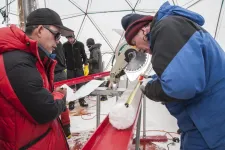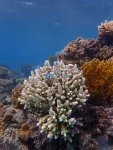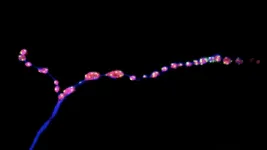15,000-year-old viruses discovered in Tibetan glacier ice
Most of the viruses were previously unknown to humans, study finds
2021-07-20
(Press-News.org) COLUMBUS, Ohio - Scientists who study glacier ice have found viruses nearly 15,000 years old in two ice samples taken from the Tibetan Plateau in China. Most of those viruses, which survived because they had remained frozen, are unlike any viruses that have been cataloged to date.
The findings, published today in the journal Microbiome, could help scientists understand how viruses have evolved over centuries. For this study, the scientists also created a new, ultra-clean method of analyzing microbes and viruses in ice without contaminating it.
"These glaciers were formed gradually, and along with dust and gases, many, many viruses were also deposited in that ice," said Zhi-Ping Zhong, lead author of the study and a researcher at The Ohio State University Byrd Polar and Climate Research Center who also focuses on microbiology. "The glaciers in western China are not well-studied, and our goal is to use this information to reflect past environments. And viruses are a part of those environments."
The researchers analyzed ice cores taken in 2015 from the Guliya ice cap in western China. The cores are collected at high altitudes - the summit of Guliya, where this ice originated, is 22,000 feet above sea level. The ice cores contain layers of ice that accumulate year after year, trapping whatever was in the atmosphere around them at the time each layer froze. Those layers create a timeline of sorts, which scientists have used to understand more about climate change, microbes, viruses and gases throughout history.
Researchers determined that the ice was nearly 15,000 years old using a combination of traditional and new, novel techniques to date this ice core.
When they analyzed the ice, they found genetic codes for 33 viruses. Four of those viruses have already been identified by the scientific community. But at least 28 of them are novel. About half of them seemed to have survived at the time they were frozen not in spite of the ice, but because of it.
"These are viruses that would have thrived in extreme environments," said Matthew Sullivan, co-author of the study, professor of microbiology at Ohio State and director of Ohio State's Center of Microbiome Science. "These viruses have signatures of genes that help them infect cells in cold environments - just surreal genetic signatures for how a virus is able to survive in extreme conditions. These are not easy signatures to pull out, and the method that Zhi-Ping developed to decontaminate the cores and to study microbes and viruses in ice could help us search for these genetic sequences in other extreme icy environments - Mars, for example, the moon, or closer to home in Earth's Atacama Desert."
Viruses do not share a common, universal gene, so naming a new virus - and attempting to figure out where it fits into the landscape of known viruses - involves multiple steps. To compare unidentified viruses with known viruses, scientists compare gene sets. Gene sets from known viruses are cataloged in scientific databases.
Those database comparisons showed that four of the viruses in the Guliya ice cap cores had previously been identified and were from virus families that typically infect bacteria. The researchers found the viruses in concentrations much lower than have been found to exist in oceans or soil.
The researchers' analysis showed that the viruses likely originated with soil or plants, not with animals or humans, based on both the environment and the databases of known viruses.
The study of viruses in glaciers is relatively new: Just two previous studies have identified viruses in ancient glacier ice. But it is an area of science that is becoming more important as the climate changes, said Lonnie Thompson, senior author of the study, distinguished university professor of earth sciences at Ohio State and senior research scientist at the Byrd Center.
"We know very little about viruses and microbes in these extreme environments, and what is actually there," Thompson said. "The documentation and understanding of that is extremely important: How do bacteria and viruses respond to climate change? What happens when we go from an ice age to a warm period like we're in now?"
INFORMATION:
This study was an interdisciplinary effort between Ohio State's Byrd Center and its Center for Microbiome Science. The 2015 Guliya ice cores were collected and analyzed as part of a collaborative program between the Byrd Polar and Climate Research Center and the Institute of Tibetan Plateau Research of the Chinese Academy of Sciences, funded by the U.S. National Science Foundation and the Chinese Academy of Sciences. Funding also came from the Gordon and Betty Moore Foundation and the U.S. Department of Energy.
CONTACTS: Zhi-Ping Zhong, zhong.393@osu.edu
Lonnie Thompson, thompson.3@osu.edu
Matt Sullivan, Sullivan.948@osu.edu
Written by Laura Arenschield, arenschield.2@osu.edu
[Attachments] See images for this press release:

ELSE PRESS RELEASES FROM THIS DATE:
2021-07-20
In order to correctly separate vehicles into classes, for instance for mobility pricing, one must be able to clearly distinguish mid-sized cars from upper class cars or small cars from compact cars. But this is becoming increasingly difficult: On photos, an Audi A4 looks almost the same as an Audi A6, a Mini One looks similar to a Mini Countryman. To date, there is no independent procedure for doing this.
Thus far, the classes in each country have been determined by experts - to a large extend at their own discretion. Empa researcher Naghmeh Niroomand has now developed a system that can classify cars worldwide based on their dimensions. Purely mathematical and fair. Thanks to it, the current classification ...
2021-07-20
FORT LAUDERDALE/DAVIE, Fla. - It's good to have friends.
Most humans have experienced social anxiety on some level during their lives. We all know the feeling - we show up to a party thinking it is going to be chock full of friends, only to find nearly all total strangers. While we typically attribute the long-lasting bonds of social familiarity to complex thinkers like humans, growing evidence indicates that we underestimate the importance of friendship networks in seemingly "simple" animals, like fish, and its importance for survival in the wild. To better understand how familiarity impacts social fishes, a group of research scientists studied this idea using schooling coral reef fish.
"We studied how the presence of ...
2021-07-20
FRANKFURT, GERMANY. When SARS-CoV-2 infects a cell, it introduces its RNA into it and re-programmes it in such a way that the cell first produces viral proteins and then whole viral particles. In the search for active substances against SARS-CoV-2, researchers have so far mostly concentrated on the viral proteins and on blocking them, since this promises to prevent, or at least slow down, replication. But attacking the viral genome, a long RNA molecule, might also stop or slow down viral replication.
The scientists in the COVID-19-NMR consortium, which is coordinated by Professor Harald Schwalbe from the Institute of Organic Chemistry and Chemical Biology at Goethe University, have now completed an important ...
2021-07-20
CAMBRIDGE, MA -- Since the Covid-19 pandemic began last year, face masks and other personal protective equipment have become essential for health care workers. Disposable N95 masks have been in especially high demand to help prevent the spread of SARS-CoV-2, the virus that causes Covid-19.
All of those masks carry both financial and environmental costs. The Covid-19 pandemic is estimated to generate up to 7,200 tons of medical waste every day, much of which is disposable masks. And even as the pandemic slows down in some parts of the world, health care workers are expected to continue wearing masks most of the time.
That toll could be dramatically cut by adopting reusable masks, according to a new study from MIT that has calculated the financial ...
2021-07-20
With the looming threat of climate change, it is high time we embrace renewable energy sources on a larger scale. Photovoltaic systems, which generate electricity from the nearly limitless supply of sunlight energy, are one of the most promising ways of generating clean energy. However, integrating photovoltaic systems into existing power grids is not a straightforward process. Because the power output of photovoltaic systems depends heavily on environmental conditions, power plant and grid managers need estimations of how much power will be injected by photovoltaic systems so as to plan optimal generation and maintenance schedules, among other important operational aspects.
In line with modern trends, if something needs predicting, you can safely ...
2021-07-20
Researchers in the BOTTLE Consortium, including from the U.S. Department of Energy's (DOE's) National Renewable Energy Laboratory (NREL) and the University of Portsmouth, have identified using enzymes as a more sustainable approach for recycling polyethylene terephthalate (PET), a common plastic in single-use beverage bottles, clothing, and food packaging that are becoming increasingly relevant in addressing the environmental challenge of plastic pollution. An analysis shows enzyme-recycled PET has potential improvement over conventional, fossil-based methods of PET production across a broad spectrum of energy, carbon, and socioeconomic impacts.
The concept, if further developed and implemented at scale, could lead to ...
2021-07-20
Neurons communicate through rapid electrical signals that regulate the release of neurotransmitters, the brain's chemical messengers. Once transmitted across a neuron, electrical signals cause the juncture with another neuron, known as a synapse, to release droplets filled with neurotransmitters that pass the information on to the next neuron. This type of neuron-to-neuron communication is known as evoked neurotransmission.
However, some neurotransmitter-packed droplets are released at the synapse even in the absence of electrical impulses. These miniature release events -- or ...
2021-07-20
Every spring, the Daylight Saving Time shift robs people of an hour of sleep - and a new study shows that DNA plays a role in how much the "spring forward" time change affects individuals.
People whose genetic profile makes them more likely to be "early birds" the rest of the year can adjust to the time change in a few days, the study shows. But those who tend to be "night owls" could take more than a week to get back on track with sleep schedule, according to new data published in Scientific Reports by a team from the University of Michigan.
The study uses data from continuous sleep tracking ...
2021-07-20
Forensics specialists can use a commercial assay targeting mitochondrial DNA to accurately discriminate between wolf, coyote and dog species, according to a new study from North Carolina State University. The genetic information can be obtained from smaller or more degraded samples, and could aid authorities in prosecuting hunting jurisdiction violations and preserving protected species.
In the U.S., certain wolf subspecies or species are endangered and restricted in terms of hunting status. It is also illegal to deliberately breed wolves or coyotes with domesticated dogs.
"If ...
2021-07-20
EAST LANSING, Mich. - Diagnosing a rare medical condition is difficult. Identifying a treatment for it can take years of trial and error. In a serendipitous intersection of research expertise, an ill patient in this case a child and innovative technology, Bachmann-Bupp Syndrome has gone from a list of symptoms to a successful treatment in just 16 months.
The paper chronicling this lightning-fast scientific response to the Bachmann-Bupp Syndrome was published in the open-access journal, eLife.
For more than 25 years, André Bachmann, professor of pediatrics in Michigan State University College ...
LAST 30 PRESS RELEASES:
[Press-News.org] 15,000-year-old viruses discovered in Tibetan glacier ice
Most of the viruses were previously unknown to humans, study finds



